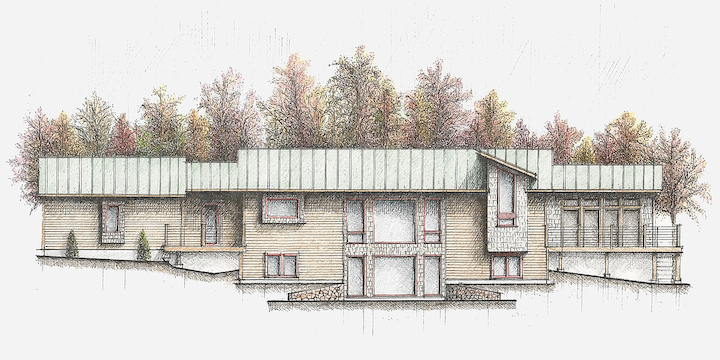In 2014, I was living in a small apartment in the San Francisco Bay Area, a few miles south of Stanford University. I wanted to improve my quality of life by purchasing a home, but real estate in the area was very expensive and prices were accelerating upwards. I decided it was time to consider a move to a more affordable locale.
For a long time, I had wanted to live in New England. When an opportunity arose to purchase an undeveloped property in southern Rhode Island, I jumped on it. This looked like a great place to build an interesting new house. I wanted the home to be comfortable, quiet, and energy-efficient. Beyond that, I was open to any and all ideas.
After a tour of a home site with an innovative local builder, I decided to design and build a house that achieves (and hopefully exceeds) a very stringent set of requirements called the Passive House building standard. I assembled a team of highly-qualified professionals who understood what we wanted to do and were up to speed on the latest advances in science-based design and construction methods.

A Passive House typically uses 80-90% less energy than a conventional American home — hard to believe, but true. The air inside the home is clean and safe, with very little temperature variation (no hot or cold spots). Occupants aren’t bothered by pollen, excessive humidity, or outside noise.
How does a Passive House achieve this?
-
Passive solar heating. The primary source of heat during the cooler months is sunlight that enters through large, south-facing windows. Wide eaves and other shading techniques are used to minimize solar gain during the warmer months.
-
Superinsulation. A passive house uses insulation with very high R-values around the main envelope, including the foundation.
-
Minimal thermal bridging. Passive house designers try very hard to eliminate thermal bridging inside the main envelope. Thermal bridging occurs when a conductive material extends from within the main envelope to the outside air.
-
No leaks! The main envelope is virtually airtight, preventing infiltration of outside air and loss of conditioned air.
-
High-performance windows and doors. European-designed windows and doors provide exceptional thermal and acoustical insulation. Features include triple glazing, multiple gaskets, warm-edge spacers, and a multi-point locking system to ensure a tight seal.
-
Whole-house ventilation. An independent ventilation system exchanges the air inside the main envelope every few hours, and includes subsystems for air filtration, energy recovery, and dehumidification.
-
Supplemental heating and cooling. Small, ductless heat pumps called mini-splits are used to maintain a comfortable temperature inside the home regardless of outside conditions. When cooling the air inside the home, heat pumps also help to reduce humidity.
Powered by the sun
To reduce my dependence on power sources that emit greenhouse gases, I decided to generate power on site using a photovoltaic system purchased from Newport Solar. An array of thirty rooftop solar panels generate up to 9000 watts during daylight hours to power the house and recharge the on-site energy storage system. Surplus power is sold to the local electric utility.
The energy storage system uses lithium batteries that charge up during the day and supply power to the house at night. During utility power outages, the batteries provide enough auxiliary power to keep the house habitable. Residential energy storage systems are growing in popularity as manufacturing costs come down; gas-powered portable generators will become a thing of the past.
Do we really need a concrete slab?
I wanted a hardwood floor in part of the finished basement, but hardwood on top of fresh concrete is not recommended because the wood can swell and warp. Defying conventional wisdom, we decided to build the basement floor without using concrete. Over seven years later, the floor is still solid with no signs of unevenness.
A Basement Floor Without Concrete tells the full story.
Project Team
- Stephen DeMetrick, home builder
- Steven Baczek AIA, lead architect
- Nancy Leslie AIA, interior designer
Unindicted co-conspirators
- Jeffrey Balch, surveyor and site engineer
- Mike Browne, Passive House certification
- Shawn Mayers APLD, landscape designer
- Daniel Roy, energy consultant

Construction photos
During the construction of the house, I took photos every few days.